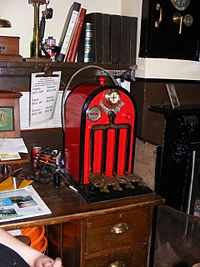Single line working using tokens
History
Early railways used slow speeds and had frequent passing places, so it was safe for trains to be driven 'on sight' as far as the driver could see was clear. However as speeds and distances between passing places increased, it was quickly found that more complex systems to avoid collisions were needed on single lines.
At first this was done using a unique object called a 'train staff' for each section of line, which the driver of each train was required to carry with him. As there was only one staff for each section, this ensured only one train could be on the line at once. It worked well if trains always alternated in direction, but if two trains in succession were required to travel in the same direction, the token had to be walked back to the start after the first train. Because of this the 'staff and ticket' system developed: the first train would be shown the staff and given a paper or metal 'ticket' to carry on the engine. The final train, in a group travelling in the same direction, would carry the staff.
With the staff and ticket system, there was little to stop the signalman issuing tickets improperly. Token systems were developed as one way around this problem, using electrically-connected machines called 'token instruments' to hold a set of objects like the earlier train staff, called 'tokens'. The machines were designed to be linked in pairs, with each pair of machines sharing a set of tokens, and designed so that only one token in the set can be removed from the instruments at any time. The first token instruments used metal batons ('electric train staffs') or discs ('tablets'), and tokens always had to be removed from one machine and returned to the other. The SVRSevern Valley Railway uses a later type of instrument called a 'key token' instrument, so named because each token resembles a large key.
The Token Instruments
The largest part of each token instrument is a 'magazine' consisting of four vertical channels, which stores each machine's stock of tokens. Because each token has a large head, wider than each channel, they can be moved around inside the magazine but not removed. Above the magazine is a lock mechanism called a 'commutator'. This is the only route by which tokens may be taken from or placed into the instrument, by turning the token like a key in a lock.
Alongside the commutator is a bell plunger used to signal to the other signalbox, a telegraph needle which moves when the plunger in either instrument is pressed, and an indicator which reminds the signalman whether a token has been released or not. Some token instruments have automatic electrical indicators, but all of the instruments on the SVRSevern Valley Railway have manual ones.
Tokens can be placed into an instrument at any time, if they fit, but a token can only be removed if all the tokens are in the two instruments, and the signalman at the other signalbox is holding down the bell plunger on his instrument.
Each instrument is numbered, and each token, like a key, only fits into the correct instrument. The tokens are also stamped with the names of the signalboxes at either end of the section they apply to, and are colour-coded, with all the tokens in a set having their handles painted a distinctive colour.
When a token has been removed from an instrument, it is usually placed in a 'token carrier', a metal holder which is about the same size and shape as an unstrung tennis racket. This enables the tokens to be passed to and from moving trains.
Operation
The signalman sending a train will alert the receiving signalman with the 'Call Attention' bell signal, and when he or she responds will, by bell signal, ask "Is the line clear for [this kind of train]", there being different signals for different train types. If the receiving signalman accepts the train, he or she will repeat the signal back, keeping the bell plunger held down on the final beat of the signal. Holding down the plunger releases the mechanism of the sending signalman's token instrument, so he or she can remove a token.
Removing the token will unlock the signal which allows trains to enter the section of line between the two signalboxes. The signalman will clear this signal, put the token into a token carrier, and give it to the footpath crew.
